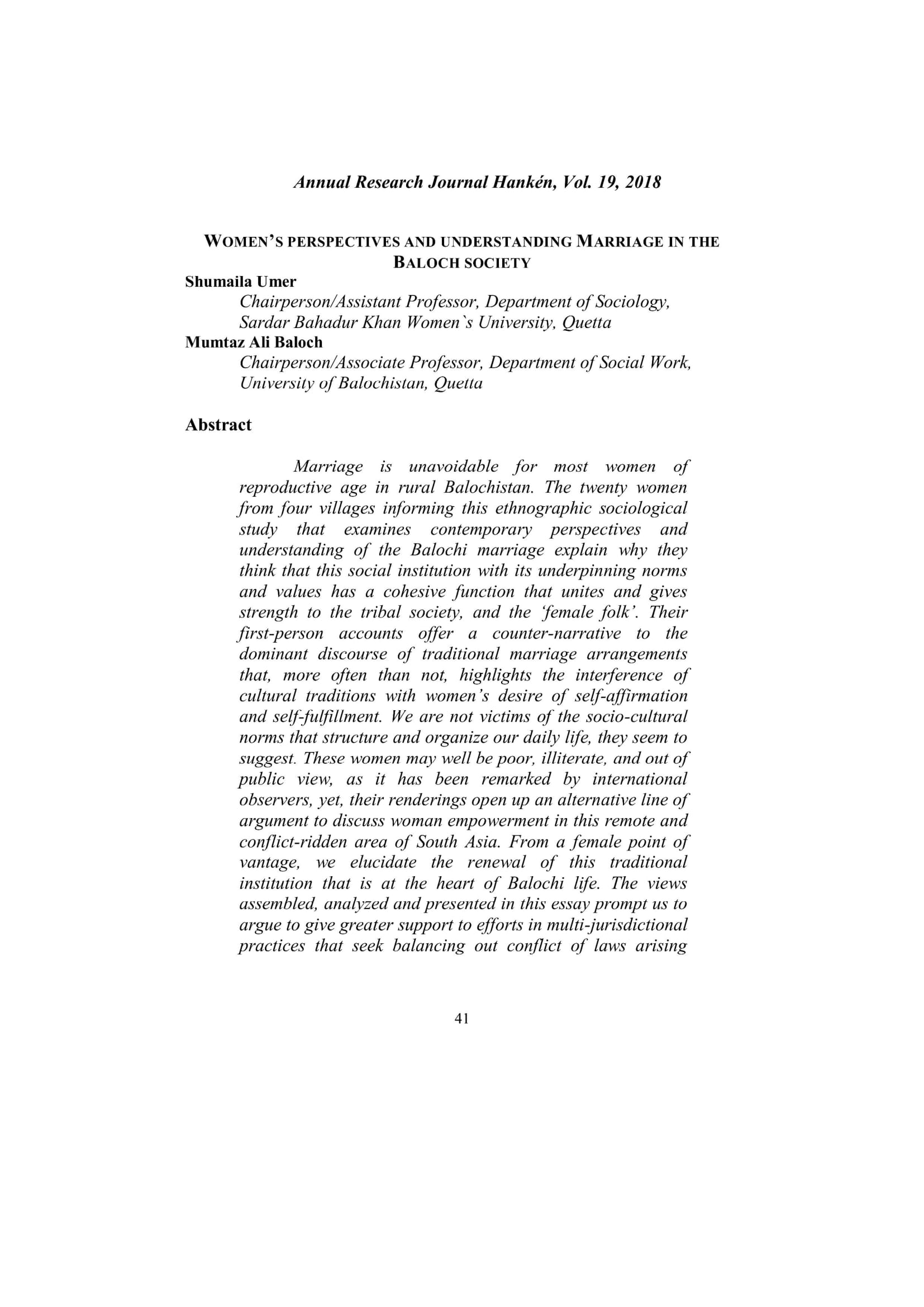WOMEN’S PERSPECTIVES AND UNDERSTANDING MARRIAGE IN THE BALOCH SOCIETY
WOMEN’S PERSPECTIVES AND UNDERSTANDING MARRIAGE IN THE BALOCH SOCIETY
Keywords:
Baloch marriages; Conflict of laws; Women’s rights, Balochistan, PakistanAbstract
Marriage is unavoidable for most women of
reproductive age in rural Balochistan. The twenty women
from four villages informing this ethnographic sociological
study that examines contemporary perspectives and
understanding of the Balochi marriage explain why they
think that this social institution with its underpinning norms
and values has a cohesive function that unites and gives
strength to the tribal society, and the ‘female folk’. Their
first-person accounts offer a counter-narrative to the
dominant discourse of traditional marriage arrangements
that, more often than not, highlights the interference of
cultural traditions with women’s desire of self-affirmation
and self-fulfillment. We are not victims of the socio-cultural
norms that structure and organize our daily life, they seem to
suggest. These women may well be poor, illiterate, and out of
public view, as it has been remarked by international
observers, yet, their renderings open up an alternative line of
argument to discuss woman empowerment in this remote and
conflict-ridden area of South Asia. From a female point of
vantage, we elucidate the renewal of this traditional
institution that is at the heart of Balochi life. The views
assembled, analyzed and presented in this essay prompt us to
argue to give greater support to efforts in multi-jurisdictional
practices that seek balancing out conflict of laws arising
Women’s perspectives and understanding Marriage in the Baloch society
from clashes between tribal, religious and civil laws and
regulations.
References
Babur, Z. U. (2007). Violence Against Women in Pakistan: Current realities
and strategies for change. Unpublished dissertation
for Masters of Arts Degree in Peace and Conflict
Studies, European University Center for Peace
Studies Stadtschlaining/Burg, Austria.). Retrieved
from http://epu. ac. at/file
admin/downloads/research/Babur. Pdf
Baloch, S.U. Using the positive lens to state Tribalism as a civilised system
in Rural Balochistan. Quetta. 2016, February 10.
Retrieve from.
http://www.bexpress.com.pk/2016/02/httpwpmep5f0gk-3n7/
Bankole, A., Singh, S., Woog, V., & Wulf, D. (2004). Risk and Protection:
Youth and HIV/AIDS in Sub-Saharan Africa. New
York.
Bhatti, N., Jamali, M. B., Phulpoto, N. N., Mehmood, T., & Shaikh, F. M.
(2011). Domestic violence against women: A case
study of district Jacob Abad, Sindh Pakistan. Asian
Social Science, 7(12), 146.
Cartwright, S., & Cooper, C. L. (1993). The role of culture compatibility in
successful organisational marriage. The Academy of
Management Executive, 7(2), 57-70.
CN (Change Newsletter). (2000). Non-Consensual Sex in Marriage
Program (NCSM), London
Daraz, U., Naz, A., & Khan, W. (2014). Early Marriage: A Developmental
Challenge to Women in Pakhtun Society. FWU
Journal of Social Sciences, 8(1), 91.
Fisman, R., Iyengar, S. S., Kamenica, E., and Simonson, I. (2006). Gender
Differences in Mate Selection: Evidence from a speed
dating experiment. The Quarterly Journal of
Economics. P. 673.
Hughes, C. (2002). Key concepts in feminist theory and research. Sage.
IPPF (2000). Reproductive Rights Wallchart, International Planned
Parenthood Foundation (IPPF) and International
Women’s Rights Action Watch (IWRAW),
Minnesota.
Kabir, R. (2007). Adolescent Girls in Bangladesh, UNICEF Dhaka.
Shumaila Umer & Mumtaz Ali Baloch
Kakar, B. Tobwal, U. Bareach, K.& Sultan, S.R. (2016). Social and Cultural
Barrier to female Education in Balochistan; An
Assessment study with a focus on district Pishin,
Balochistan Review, 104(1), 163-172.
Laws, W. L. U. M. (2013). Child, Early and Forced Marriage: A MultiCountry Study. A Submission to the UN Office of the
High Commissioner for Human Rights(OCHCR).
Macfarlane, A. (2002). Marriage and Love in England: Modes of
Reproduction 1300-1840, Oxford, Basil Blackwell
Ltd.
Majali, V. (2012). The socio-cultural factors affecting the participation of
women in agricultural development: Khezana Village
in Alice District (Doctoral dissertation, Master
thesis). University of Fort Hare).
Majeed, G. (2010). Ethnicity and ethnic conflict in Pakistan. Journal of
Political Studies, 17(2), 51-63.
Mensch, B. (1998). The Uncharted Passage: Girls’ Adolescence in the
Developing World, The Population Council, New
York.
Nair, J. (2006). Prohibited Marriage: State Protection and Child Wife’,
contribution to Indian Sociology.
NCTPE, 2003. Old Beyond Imaginings. Ethiopia Harmful Traditional
Practices. National Committee on Traditional
Practices in Ethiopia, Addia Ababa.
Naz, A. (2011). Socio-Economic and Political Obstacles in Women's
Empowerment in Pakhtun Society of District Dir (L),
Khyber Pakhtunkhwa, Pakistan. FWU Journal of
Social Sciences, 5(1), 51-72
Naz, A., Khan, W., Daraz, U., Hussain, M., & Chaudhry, H. U. R. (2012).
The Relational Analyses of Pakhtun Social
Organization (Pakhtunwali) and Women’s Islamic
Rights Relegation in Malakand Division, KPK
Pakistan Arab. International Journal of Sociology
and Anthropology, 4(3), 63-73.
Women’s perspectives and understanding Marriage in the Baloch society
Paterson, R. (2008). Women's empowerment in challenging environments: a
case study from Balochistan. Development in
Practice, 18(3), 333-344.
Rawson, B. (2000). Marriage, Divorce, and Children in Ancient Rome,
Clarendon Press, Oxford.
Sajid, N.B. Sadiq, H.A. (2016). Cultural Ethics in Life of Baloch.
Balochistan Review, 104(1), 65-80.
Shaheed, Farida. (1990). “Pakistan's women: an analytical description”.
Islamabad: NORAD.
Taylor, D. (1993). Report of the Pakistan Commission on the Status of
Women’, Government of Pakistan: Servile Marriage:
A Definition, a Survey, and the Start of a Campaign
for Change, Anti-Slavery International, London.
UNDESA (2000). World Marriage Patterns Wallchart, UN Department of
Economic and Social Affairs.
Umer. S., Othman. Z., Hassan. K., (2016). Socio-Cultural Obstacles to
Women's Participation in Politics, In Rural Areas of
Balochistan, Pakistan. International Journal of
Business and Social Science, Vol. 7, No. 10.
Umer. S., Othman. Z., Hassan. K., (2016). Education and Empowerment of
the Women in Rural Areas of Balochistan: The Views
of Baloch Tribal Men. International Journal of
Humanities and Social Science, Vol. 6, No. 10.
Whitehead, J. (1995). Modernising the Motherhood Archetype: Public
Health Models and the Child Marriage Act of 1929’,
Contributions to Indian Sociology, 29 (1-2)


